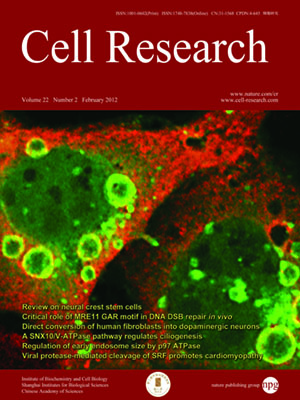
Volume 22, No 2, Feb 2012
ISSN: 1001-0602
EISSN: 1748-7838 2018
impact factor 17.848*
(Clarivate Analytics, 2019)
Volume 22 Issue 2, February 2012: 360-371
ORIGINAL ARTICLES
Cleavage of serum response factor mediated by enteroviral protease 2A contributes to impaired cardiac function
Jerry Wong1, Jingchun Zhang1, Bobby Yanagawa1, Zongshu Luo1, Xiangsheng Yang2, Jiang Chang2, Bruce McManus1 and Honglin Luo1
1James Hogg iCAPTURE Centre, Providence Heart + Lung Institute, St Paul's Hospital and Department of Pathology and Laboratory Medicine, University of British Columbia, 1081 Burrard Street, Vancouver, BC V6Z 1Y, Canada
2Center for Molecular Development and Disease, Institute of Biosciences and Technology, Texas A&M Health Science Center, Houston, TX 77030, USA
Correspondence: Honglin Luo,(honglin.luo@hli.ubc.ca)
Enteroviral infection can lead to dilated cardiomyopathy (DCM), which is a major cause of cardiovascular mortality worldwide. However, the pathogenetic mechanisms have not been fully elucidated. Serum response factor (SRF) is a cardiac-enriched transcription regulator controlling the expression of a variety of target genes, including those involved in the contractile apparatus and immediate early response, as well as microRNAs that silence the expression of cardiac regulatory factors. Knockout of SRF in the heart results in downregulation of cardiac contractile gene expression and development of DCM. The goal of this study is to understand the role of SRF in enterovirus-induced cardiac dysfunction and progression to DCM. Here we report that SRF is cleaved following enteroviral infection of mouse heart and cultured cardiomyocytes. This cleavage is accompanied by impaired cardiac function and downregulation of cardiac-specific contractile and regulatory genes. Further investigation by antibody epitope mapping and site-directed mutagenesis demonstrates that SRF cleavage occurs at the region of its transactivation domain through the action of virus-encoded protease 2A. Moreover, we demonstrate that cleavage of SRF dissociates its transactivation domain from DNA-binding domain, resulting in the disruption of SRF-mediated gene transactivation. In addition to loss of functional SRF, finally we report that the N-terminal fragment of SRF cleavage products can also act as a dominant-negative transcription factor, which likely competes with the native SRF for DNA binding. Our results suggest a mechanism by which virus infection impairs heart function and may offer a new therapeutic strategy to ameliorate myocardial damage and progression to DCM.
Cell Research (2012) 22:360-371. doi:10.1038/cr.2011.114; published online 19 July 2011
FULL TEXT | PDF
Browse 2058


